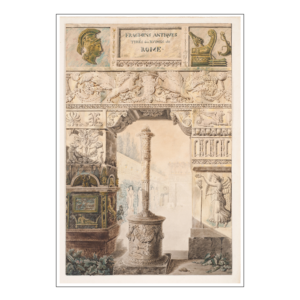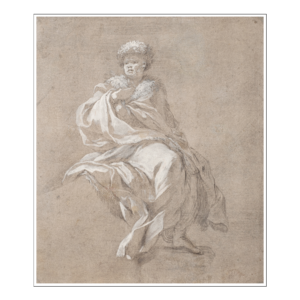Pierre Lacour
Bordeaux 1745-1814
Figures near Castello Ruspoli in Vignanello
Black chalk.
Signed with pen and brown ink lower left A. Lacour 82.
Inscribed with black chalk upper left a vignailla.
On three assembled pieces of paper (260 x 193 mm – 10 1/4 x 7 5/8 in.) laid down on paper (270 x 222 mm – 10 5/8 x 8 3/4 in.).
Trained in Bordeaux in the workshop of a medal and fine stone engraver, Pierre Lacour befriended Jean-Joseph Taillasson, another significant painter from Bordeaux. They both went to Paris to improve their skills and in June 1764 entered the workshop of Joseph Marie Vien, the painter then in vogue. Admitted to compete for the Grand Prize of the Royal Academy of Painting and Sculpture for three consecutive years, Lacour succeeded in winning the second prize in 1769. He managed to obtain a commission, that the decorator Deleuze entrusted him with, for the execution of the figures in the stage design for the Théâtre Favart, as well as a commission for the painting for the choir of the Cathedral of Lisieux. These commissions allowed him to afford a trip to Italy the following year. During this trip, he kept a diary recording his visits and impressions. From Rome, he sent some works to the Academy of Bordeaux that agreed to admit him for the presentation of a reception piece.
Back in Bordeaux, the artist quickly achieved success in fashionable Bordeaux society. François Armand de Saige, General Counsel to the parliament of Bordeaux and future Mayor, commissioned eight large history paintings to Lacour for the decoration of the gallery in his mansion (now the Prefecture). Pierre-Paul Nairac, ship owner and refiner, commissioned a portrait that he intended to place in his new hôtel particulier built by Victor Louis. In 1775 Lacour presented his reception piece to the Academy that received him as an artist and amateur. He made his career there until it was closed and even opened a School of Drawing. The commissions started coming in and the artist enjoyed a full and successful career even at the outbreak of the Revolution. After the troubled times, he was one of the founders of the Museum of Fine Arts in 1801, created from the collection of the former academy and with the contribution of the state.
This drawing comes from a group formerly on the art market, most of the drawings bearing different types of inscriptions. The inscription P. Lacour, followed by the abbreviation pf with a number from 1 to 5 and accompanied by a small informative sentence on the left-hand side, appears on the majority of them. It seems to refer to a particular classification, pf meaning portfolio. As for the inscription A. Lacour followed by a number, it could point to Antoine Lacour’s authorship. But it could also have been added on Pierre Lacour’s drawings which were given to Antoine at the occasion of a division – or at least meant to be given to him, since they eventually stayed with the rest of the group. The characteristic handwriting of the inscription a vignallia logically belongs to the author, who wrote down the name of the place he executed the drawing, sometimes even misspelled it, to remember it. The appearance of this inscription on drawings indifferently bearing the inscription p. Lacour or A. Lacour seems to indicate that these drawings should actually all be attributed to one artist only, very probably Pierre Lacour the elder.
Condition report: As one can see on the photos, the artist added paper strips at the bottom (28 x 193 mm) and on the left (27 x 230 mm). Minor losses in upper and lower right corners. A few studio stains which do not impair the visibility.
The sheet is pasted at the four corners and partially on the left and right edge – to a more recent sheet of paper with irregular edges.
Taking the drawing off the mount would allow to see the study of a draped woman executed on the verso and visible through the paper when held up to the light.




